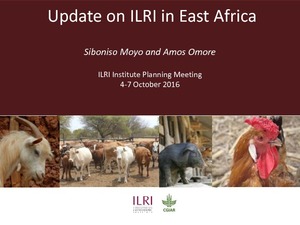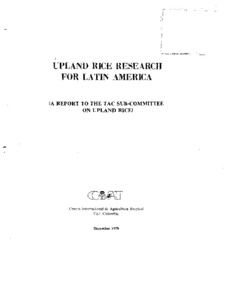Un tipo ideal de planta de yuca para rendimiento máximo [conjunto audiotutorial]
This audiotutorial unit (cassette, printed script, 76 color slides, study guide, self-evaluation test), prepared by the Communications Support Unit at CIAT, is available for use with a manually or automatically synchronized slide projector/cassette tape reccorder. Each unit is a vailabIe from the Distribution Office at a cost of US$ 50; photocopies of the study guide alone can be obtained from the Cassava Information Center. The objective of this unit is to present some of the results of research conducted by the physiology Section of CIATs Cassava Program.
Trends in on-farm performance testing of cattle and sheep in sub-Saharan Africa
Summarises past and present experiences with livestock performance testing in sub-Saharan Africa and outlines the role of networks in improving on-farm testing through the use of standardised testing methods and rapid data handling and feedback. Includes data on the distribution of cattle and sheep populations by ecological zone in sub-Saharan Africa. Presents current programmes for on-farm and on-station performance recording.
Tropical secondary forests in Asia: introduction and synthesis
This paper provides the general objectives of the special issue: secondary forests in Asia: their diversity, importance and role in future environmental management. It provides a brief overview of the renewed attention to tropical secondary forests and sketches the history of research on this subject.
Trypanotolerant livestock in West and Central Africa. Volume 2. Country studies
Information on trypanotolerant livestock in Senegal, the Gamia, Guinea Bissau, Guinea, Sierra Leone, Liberia, Mali, Upper Volta, Ivory Coast, Ghana, Togo, Benin, Nigeria, Cameroon, Central African Republic, Gabon, Congo and Zaire, particularly livestock numbers & distribution, information available on trypanotolerant cattle, sheep & goats, research and development activities, w. a selected bibliography.
Trypanotolerant livestock in West and Central Africa. Volume 3. A decade's results
This volume presents major results obtained since the publication of volume 1 and 2 and updates national data on trypanotolerant cattle. The first part analyses populations and their trends between the two surveys and reviews research activities and development activities. It also gives recent information available on the potential and utilisation of trypanotolerant livestock. Part two presents recent data for the 18 study countries, as well as for Equatorial Guinea which was not covered in volume 2.
Utilization of research results on forage and agricultural by-product materials as animal feed resources in Africa. Proceedings of the first joint workshop
Presents and discusses research results on feed resources, agroindustrial by-products utilisation, forage production, use of crop residues, dairy feeding systems, feeding strategies, introduction and adoption of improved forage technologies, nutritive value of different forages, effects of management on animal performance, effect of supplements on feed utilisation, potential of agricultural by-products as animal feeds, and effects of management on pasture grasses & legumes; and evaluates the utilisation of these results by smallholders.
Upland rice in Latin America : production, constraints and research proposals designed to improve productivity in the upland sector in the Latin American region
Utilisation de l'eau tritiee dans la recherche sur l'elevage en Afrique: Theorie, application, methodologie et lacunes potentielles de la technique
Presents a theoritical outline of the techniques in the use of tritiated water (HTO) which can be used to estimate total body water, body composition, water turnover, milk intake and feed intake. Highlights its potential errors and gives a comprehensive methodology for the use of tritiated water under field conditions.
Utilizacion de la tierra e importancia de la yuca en la finca DRI en los Departamentos de Atlantico, Bolivar, Cordoba y Sucre
The results of a survey conducted in 1983 among 416 farmers participating in the integrated rural development project (DRI, Colombia) in Atlantico (60), Bolivar (66), Cordoba (156), and Sucre (134), on land use and importance of cassava within the farming system, are presented. Except for Bolivar, where cassava and yam plantings decreased, increased land use attributable to increased credit availability was observed. In general, 1.7 ha cassava was planted per farm in 1982-83, mainly in association with yam, maize, and plantains; 55 percent of the land planted included cassava.
Water resource research and education in mountain communities
High elevation páramo (wetland) ecosystems in the Andes are important water sources for local communities and downstream agricultural and urban users. These headwater catchments, however, are often impacted by human activities (eg agricultural production) that affect both stream water quality and flow. Knowledge about water availability, quality, and use is essential for effective management but is often lacking, particularly in smaller mountain communities.








